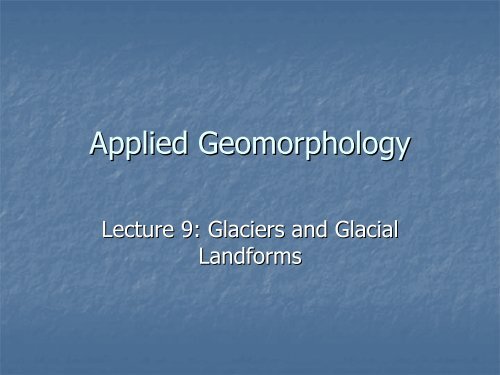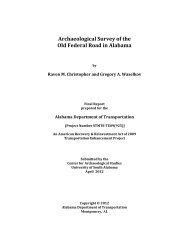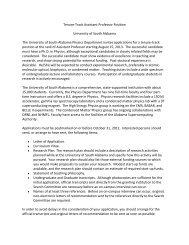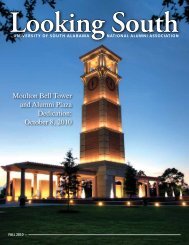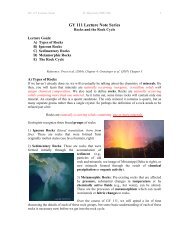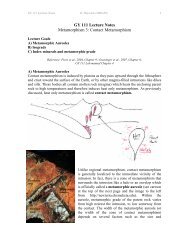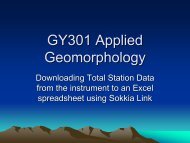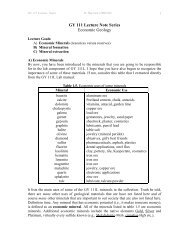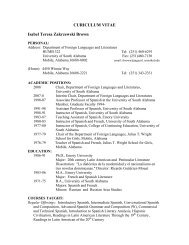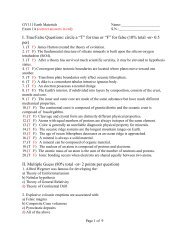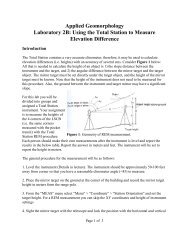Lecture 8: Glacial Landforms
Lecture 8: Glacial Landforms
Lecture 8: Glacial Landforms
- No tags were found...
Create successful ePaper yourself
Turn your PDF publications into a flip-book with our unique Google optimized e-Paper software.
Applied Geomorphology<strong>Lecture</strong> 9: Glaciers and <strong>Glacial</strong><strong>Landforms</strong>
Types of Glaciers• Valley (Alpine): rivers of ice that flowthrough valleys to lower elevations• Continental: large ice masses that coversignificant portions of continents and are amile or more thick• Currently only 2 continental glaciers exist:the Greenland and Antarctic ice sheets
Alpine Glacier• Alpine glaciers oftendisplay lateral andmedial morainesLateral moraineMedial moraine
Continental Glacier• Thick ice masses actuallydepress the lithospherebelow sea level
<strong>Glacial</strong> Ice• Accumulates where snowfall inwinter exceeds melting insummer• When snow is greater thanseveral meters thick it iscompressed into a morecompact form termed firn• When the snow/firnlayer is >30m thick the material iscompacted into pure ice
<strong>Glacial</strong> Ice• <strong>Glacial</strong> ice will recrystallize under the pressure ofthe overlying snow/firnto form a polygonaltexture (similar to granoblastic metamorphicrocks)
<strong>Glacial</strong> Budget• Accumulation zone: the “recharge” area of the glaciermarked by fresh snowfall• Ablation zone: zone of melting or sublimation where theglacier is losing mass
<strong>Glacial</strong> Movement• Plastic flow: under the influence of gravityglacial ice will undergo plastic flow asmuch as several meters per year• Basal slip: under sufficient pressure thebasal ice in a glacier will melt allowing theentire glacier to undergo basal slip up to akilometer per year
Basal Melting• Remember that H 2 O is an unusualcompound in that its solid phase is lessdense than its liquid phase2LiquidPressure1SolidGas0 Temperature100
Alpine <strong>Glacial</strong> <strong>Landforms</strong>• U-shaped valleys are very characteristic ofalpine glaciation
Alpine <strong>Landforms</strong>• Horn• Arete• Cirque
• CrevassesAlpine Landform
Alpine Glaciation• After glacier has retreated severaldistinctive landforms are left:• Arete• Serated ridge• Cirque• Horn• Waterfall
<strong>Glacial</strong> Sedimentation• Direct deposition by melting ice depositsunsorted material termed moraine• Outwash plain contains sorted and beddedalluvial fans but the material is extremelyimmature (angular, many lithic andfeldspar grains)• Lake sediments termed glacial varves formin numerous lakes in outwash plain
<strong>Glacial</strong>Sediments• Glaciershave anunlimitedcarryingcapacity
Continental Glaciation• <strong>Landforms</strong> areproduced by themotion of a thick icesheet• Drumlins• Eskers• Kettle Lakes• Varves• Till
Continental Glaciation Landform• Polished and striatedbedrock• Roche moutoneeFeatures
Ice Shelves• Large portions ofcontinental glaciersthat are floating inthe oceans
Isostasy• Floating ice isbuoyed up by aforce equal to theweight of thedisplaced fluid
Pleistocene Glaciation• Wisconsin glacialmaximum: 18,000years ago
Astronomical Effects• Earth’s s Elliptical orbit• Earth’s “eccentricity”:: the variation of apogeeposition• The above combine to give an approximate25,000 year cycle of glaciation favorableconditions• Remember that a continent must still be at ahigh latitude before continental glaciation ispossible


